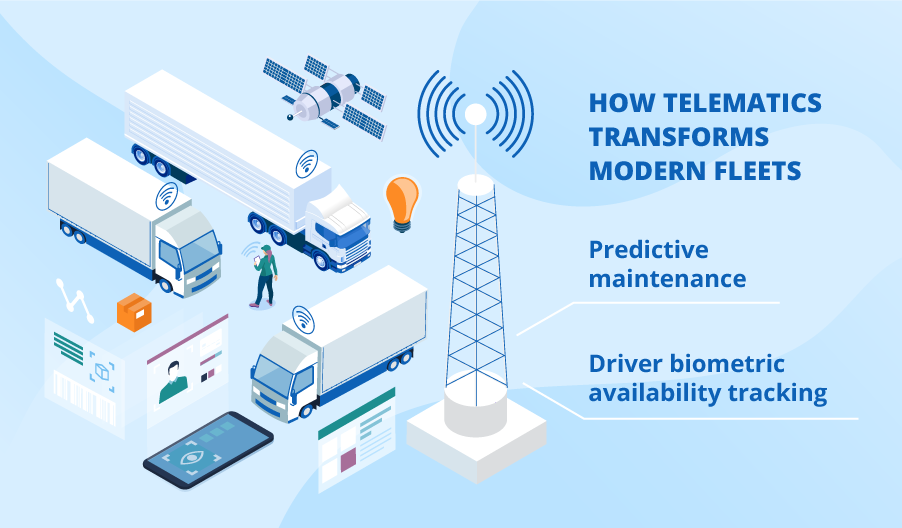Two Breakthrough Ways Telematics Transforms Modern Fleets
Telematics is persistently making it to the Big Data analytics in the automotive. The rapid advancement of smart devices has led to the shift in utilizing telematics and processing the abundant data it records. The age of simple data gathering is steadily giving way to the age of data mining and further – to machine learning, as we are moving to fully autonomous vehicles. What does it imply?

Telematics of the new generation can produce terabytes of the so-called smart data that can be acted upon in real time, without being sent to the centralized system for further analysis. It is extremely important in view of the level of connectivity modern vehicles possess.
Imagine that all the data can be processed in no time, and help make an instant driving decision, be it choosing an optimal route or planning an on-route repair. The expansion of 3G and LTE technologies providing extensive coverage results in the always-in-touch situation, when cars are constantly connected. It has given a desired impetus to the development of telematics, making it possible to use it for predicting future trends and events, and even delegate some driving responsibilities to the vehicle itself. Below are the two technologies that clearly showcase how modern telematics revolutionizes fleets.
Predictive maintenance
Predictive or condition-based maintenance is based on predictive analytics and processing of the data streaming from the car in real time directly to the main computer to help identify soft spots where breakdowns are likely to occur.
The idea behind predictive maintenance lies in the proven fact that most breakdowns do not occur due to the vehicle age as it is widely believed. Independent surveys indicate that 89% of them are simply random.
In this regard, traditional approach to maintenance and repair, based on a car’s age and an estimated lifecycle of the car parts, as well as prescheduled checkups, does not work. The high percentage of “unplanned” breakdowns explicitly indicates that a problem may occur at any time, for instance right after the checkup, or long before it. Predictive maintenance helps significantly decrease the likelihood of unexpected breakdowns, and cut costs on maintenance and repair as they are conducted when they are needed, not when they are planned.
Well, how does it work?
A big part, from monitoring the inside temperature and humidity to tracking the engine health, is performed by sensors installed in various vehicle parts. Then the gathered data is processed using predictive analytics models detecting every anomaly that may potentially cause a breakdown. Thus, cars literally get diagnosed in real time, and maintenance and repair activities are conducted at the best time possible.
The biggest challenge lies in what should be considered an anomaly against the proper functioning. It certainly needs a clear definition, since errors in identifying a problem may entail additional expenses.
The impact of the predictive maintenance utilization on the fleet performance speaks for itself. Surveys showcase it helps reduce maintenance costs by up to 30%, and the possibility of unexpected breakdowns by up to 75%. In the long run, it helps cut fleet downtime, decrease wear and tear, and even correct improper driver behavior. Fleet managers can access predictive maintenance information through a stand-alone app or a fleet management system.
Driver biometric availability tracking
The Level 2 self-driving vehicles are already here (hi, Tesla Autopilot). The Level 3 ones are looming on the horizon, with some OEMs claiming to even jump directly to Level 4. It means cars are now able to assume certain driving responsibilities, and somehow facilitate the hard work of driving.
However, one shouldn’t think semi-autonomous cars are a perfect place to lean back and enjoy a cup of lavender latte now. Driver intervention is steel needed at times, and this implies a driver still has to ALWAYS be on alert.
In this regard, traditional driver monitoring techniques, such as reviewing MVRs or geofencing, turn out to be useless, as far as driver alertness has nothing to do with how often they unnecessarily accelerate or resort to harsh braking. When both a system and a human rely on each other in terms of vehicle control, the system should “know” each time a human gets distracted.
Ever since semi-autonomous vehicles stopped being fiction, the masterminds behind the technology have been urging that robust human-machine interaction is crucial to push it forward. Nowadays, enhanced by modern telematics, it has become one of the breakthrough driver monitoring tools able to track the so-called driver biometric availability.
Driver biometric availability refers to a driver’s preparedness to take over the vehicle from the semi-autonomous system when needed. It tracks a driver’s physical indicators, such as body position, gaze direction, facial features, etc. that reflect a driver’s overall alertness, and produces sound notifications in case a driver gets distracted or is falling asleep.
Camera-based systems are the latest achievement in the field of driver monitoring. According to the ABI Research, the market is going to reach 17.5 million shipments by 2026.
The quickly developing technology sparked the appearance of the vision analytics startups, such as FotoNation, Gestigon and others, designing smart solutions including gesture and face recognition that are used to identify whether a driver is vigilant. The recent breakthrough in this field is iris recognition. It is able both to recognize the state of drowsiness, and, as a result, boost road safety, and identify a car owner, thus preventing thefts.
Conclusion
Telematics has come a long way from mere GPS tracking to Big Data analytics, and here is more to come. In the near future we are certainly going to witness a surge in the investment in telematics, V2V and V2I technologies from the side of the OEMs strongly aimed at developing a totally self-driving car. The road is oh so far yet, but there is absolutely no doubt: the two abovementioned technologies are just milestones on the way to a fully autonomous vehicle, and telematics is going to be one of its chief enablers.

